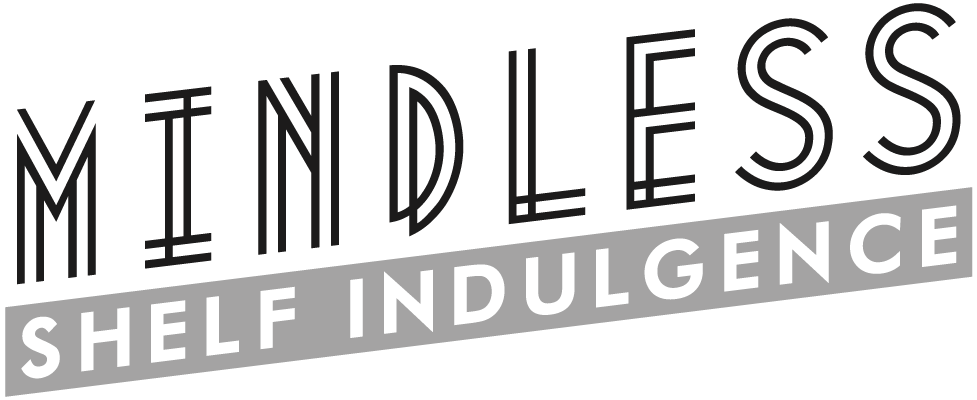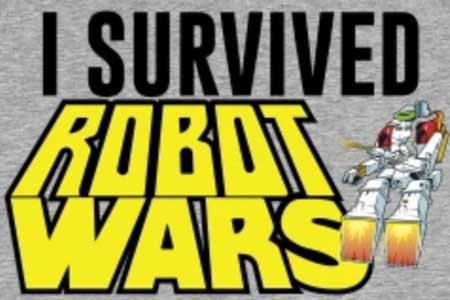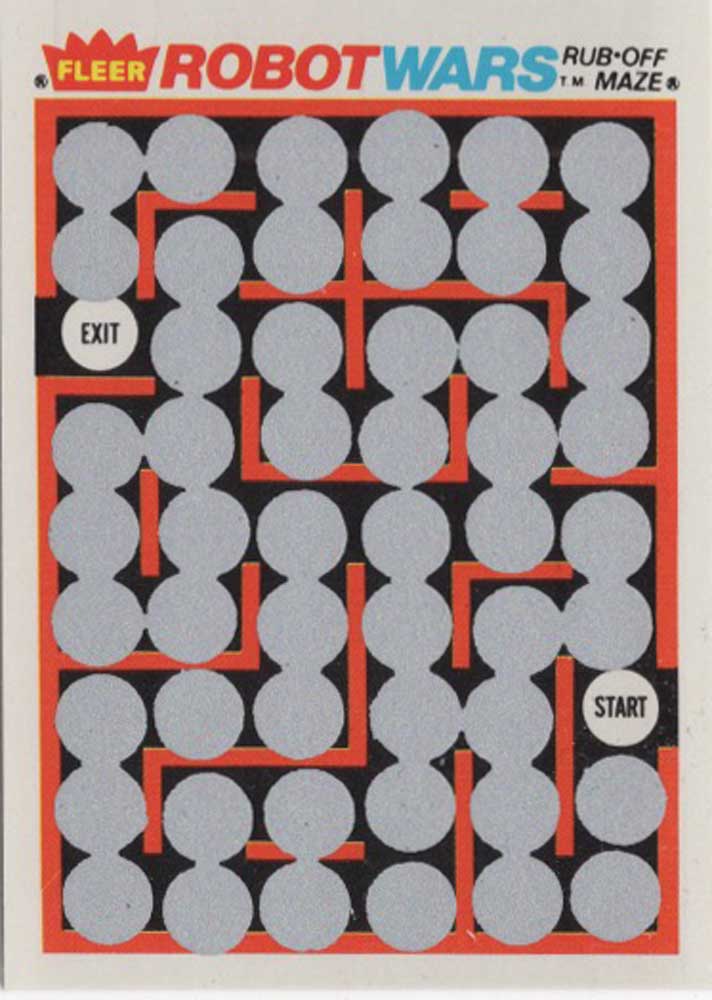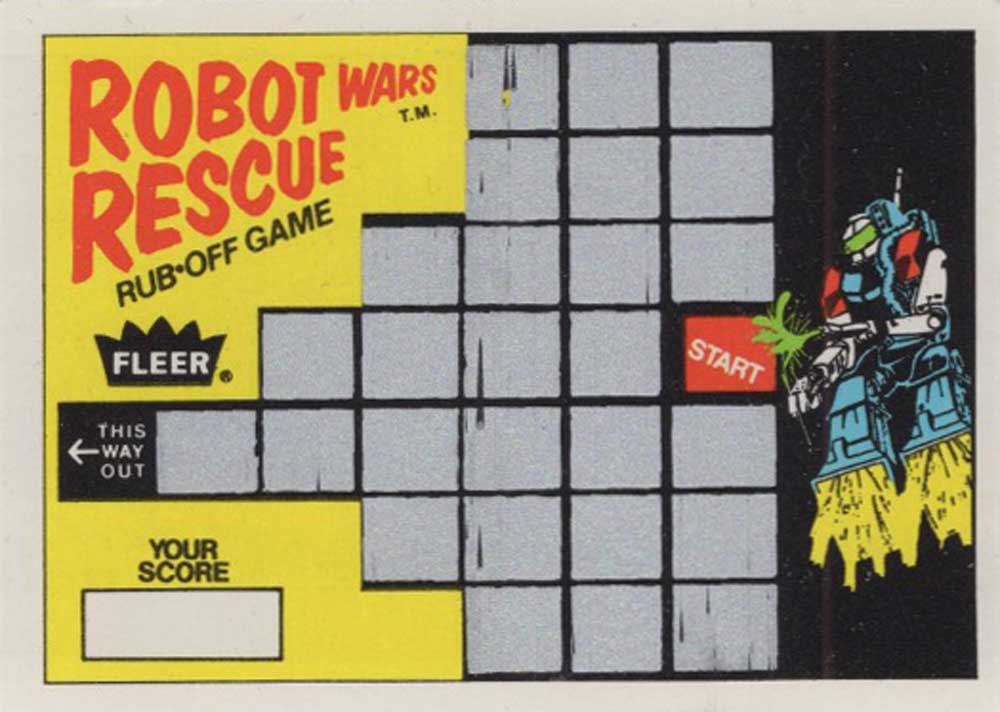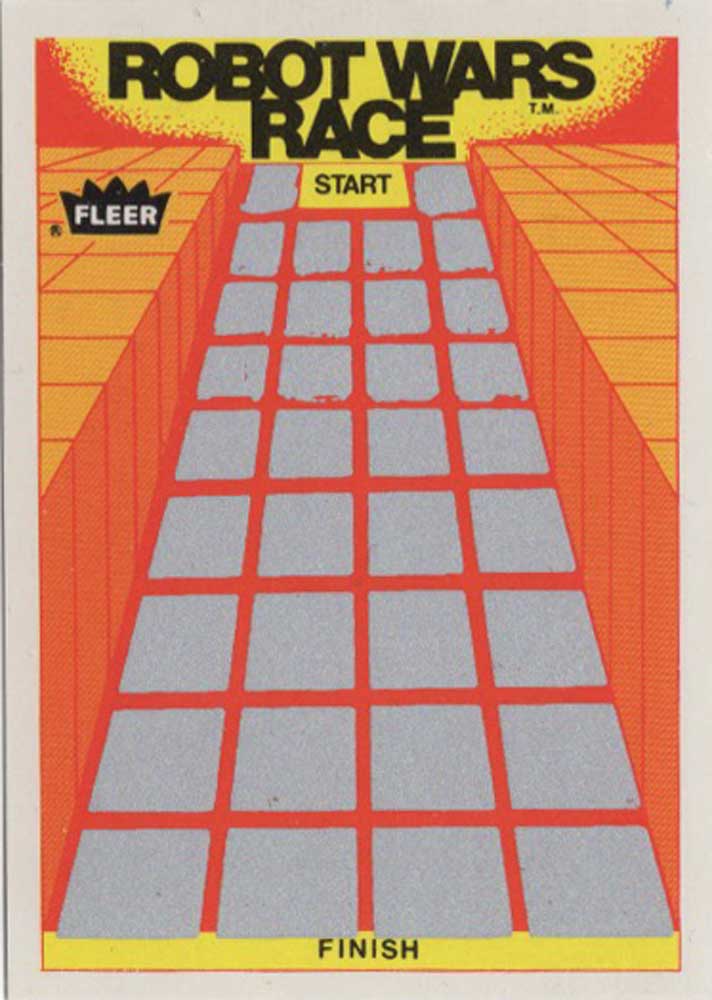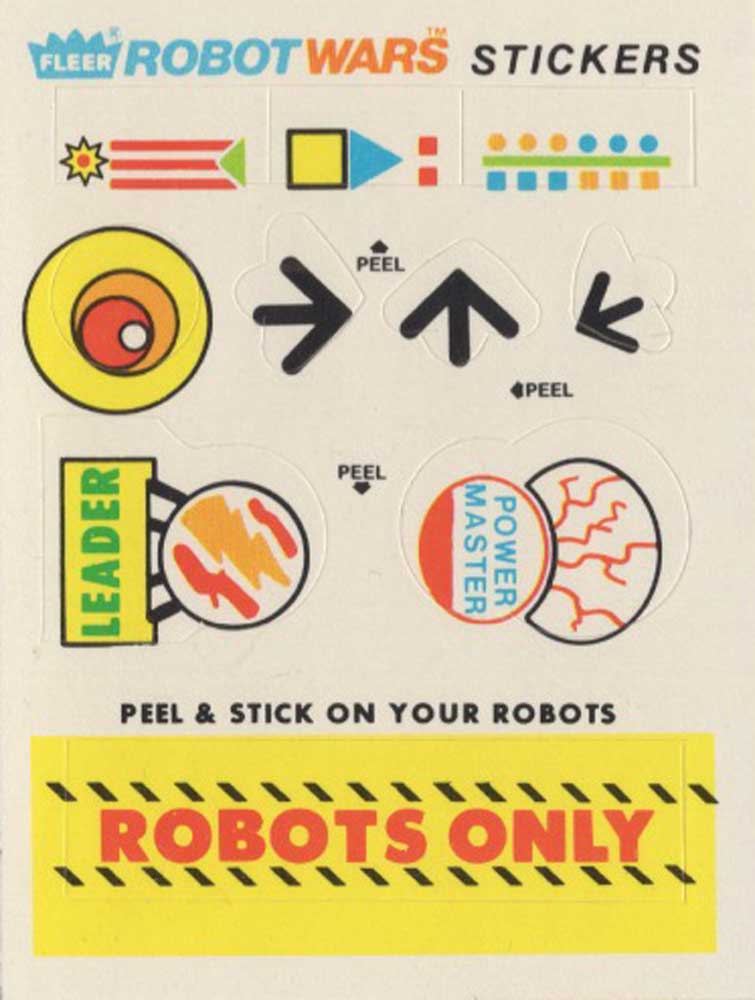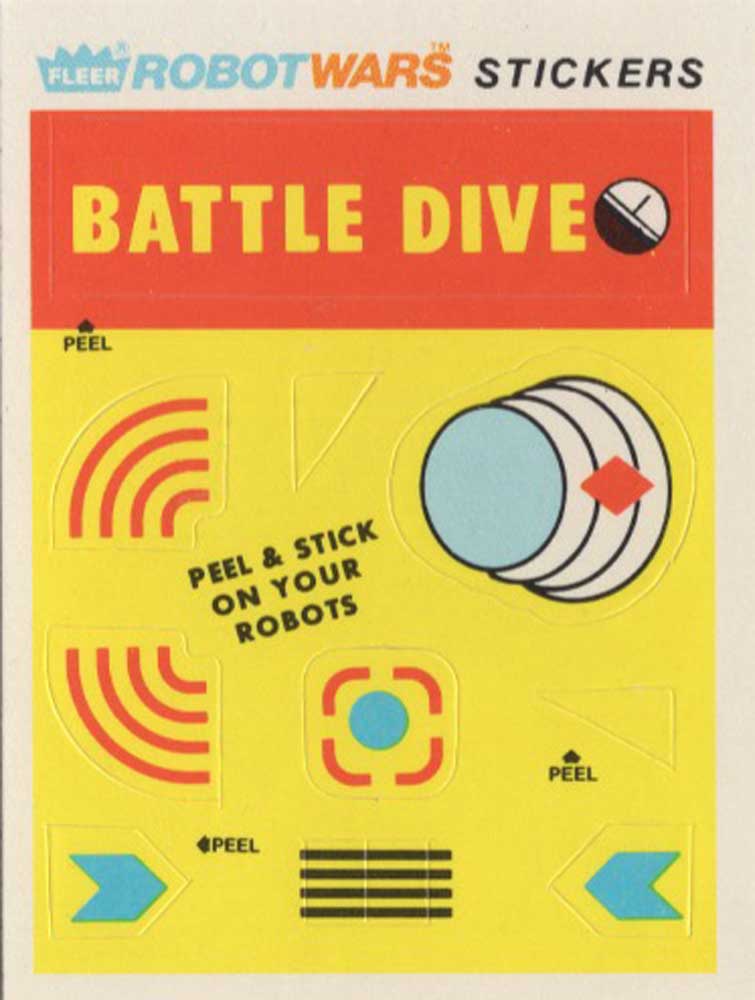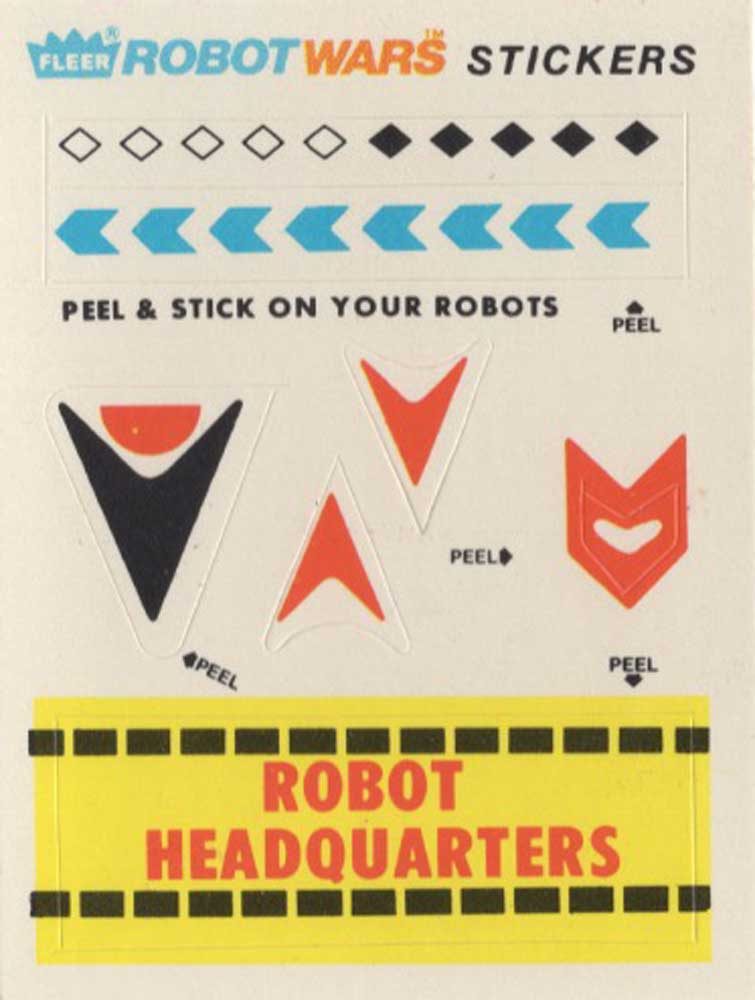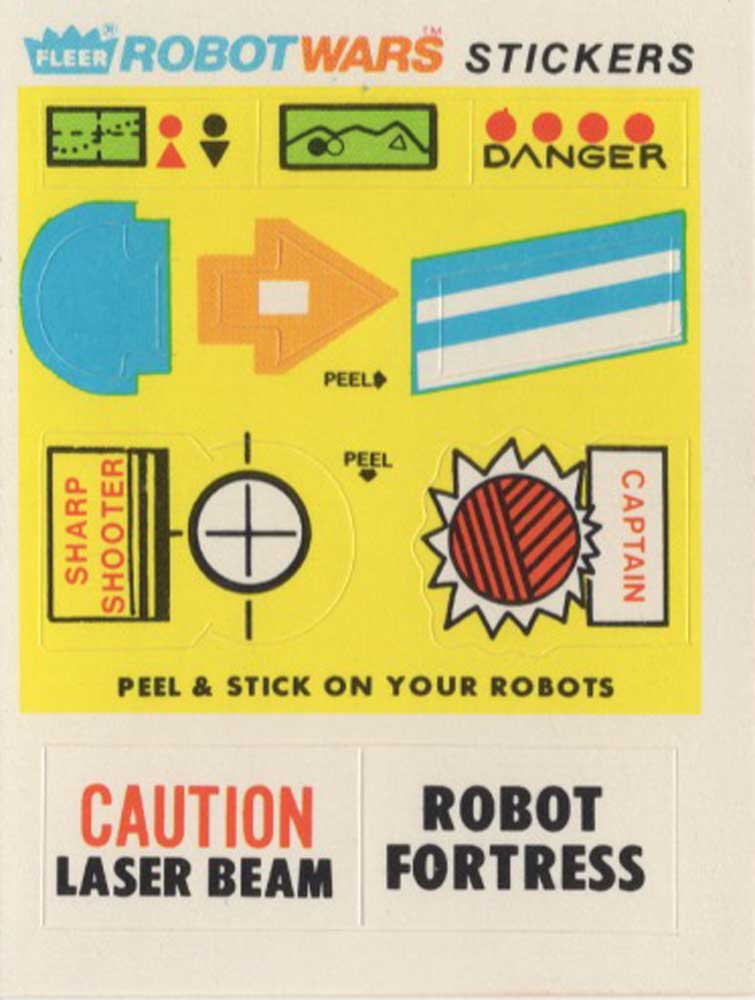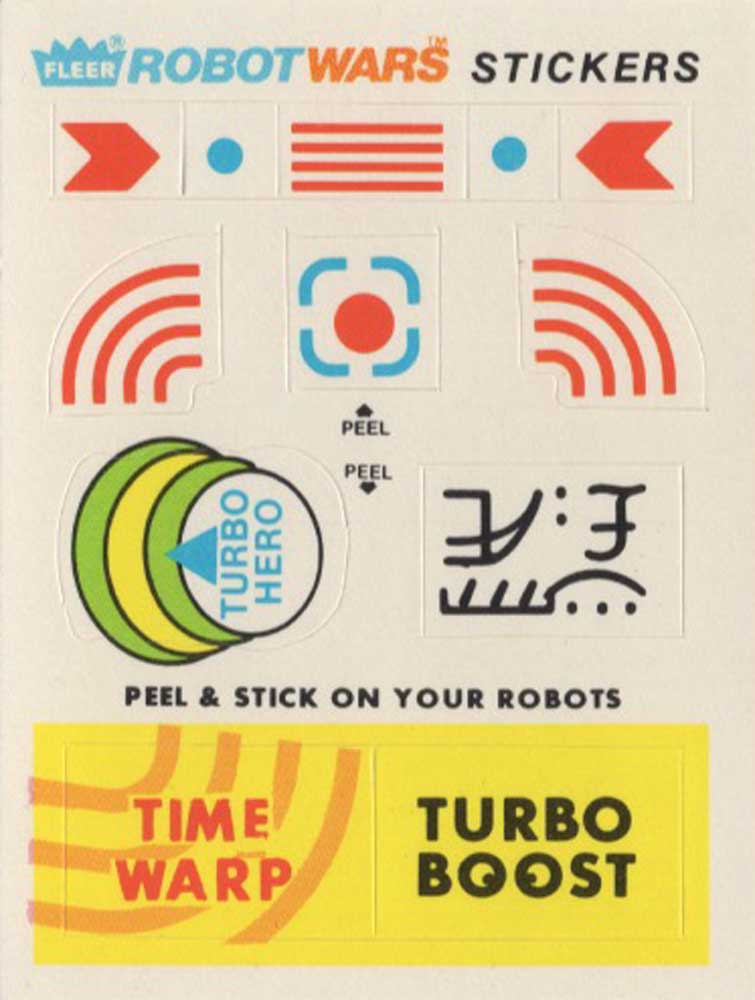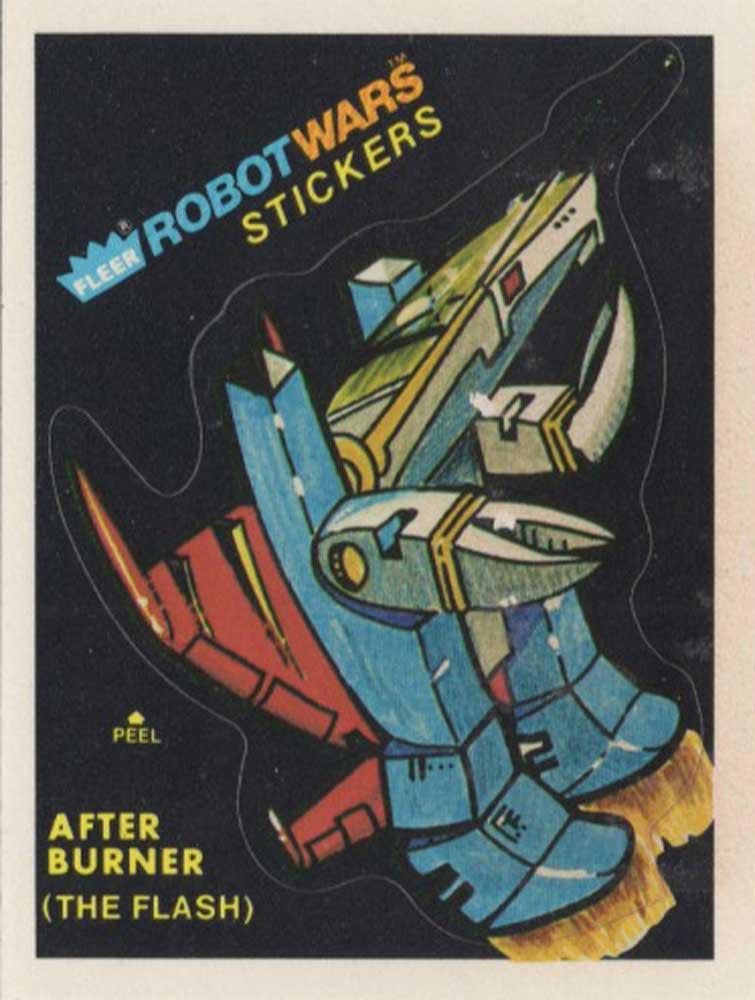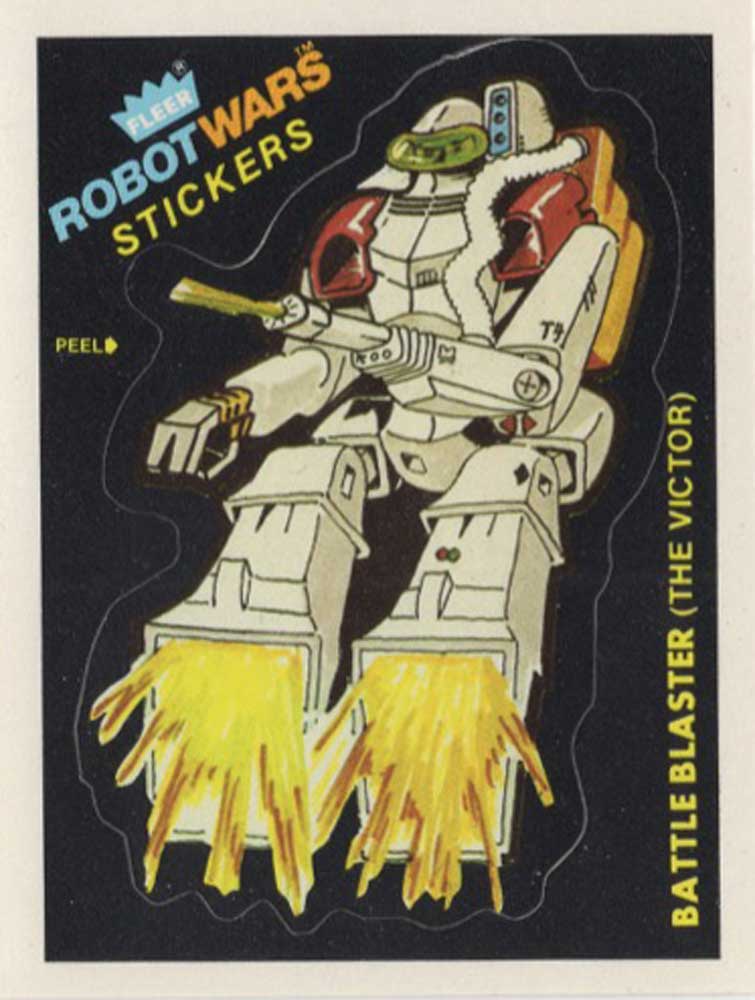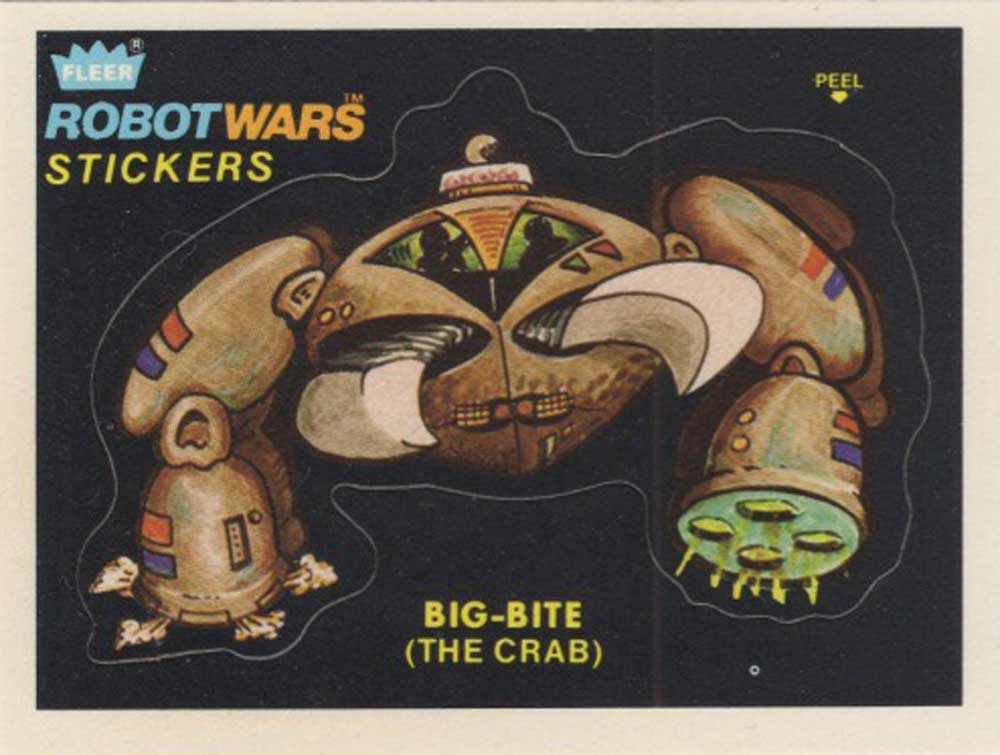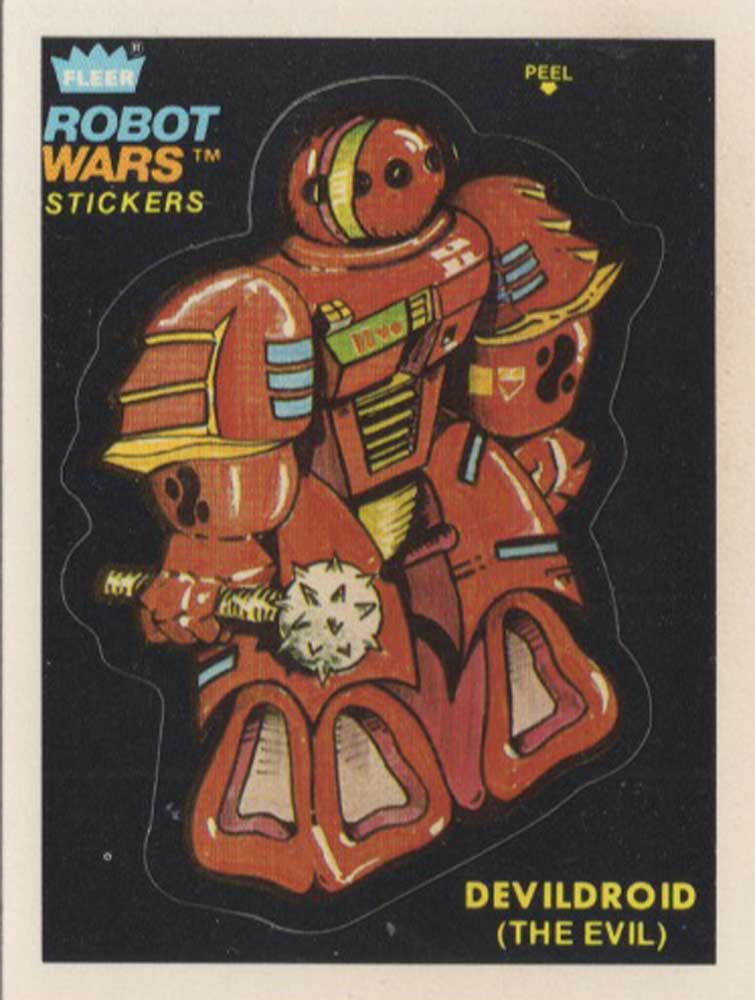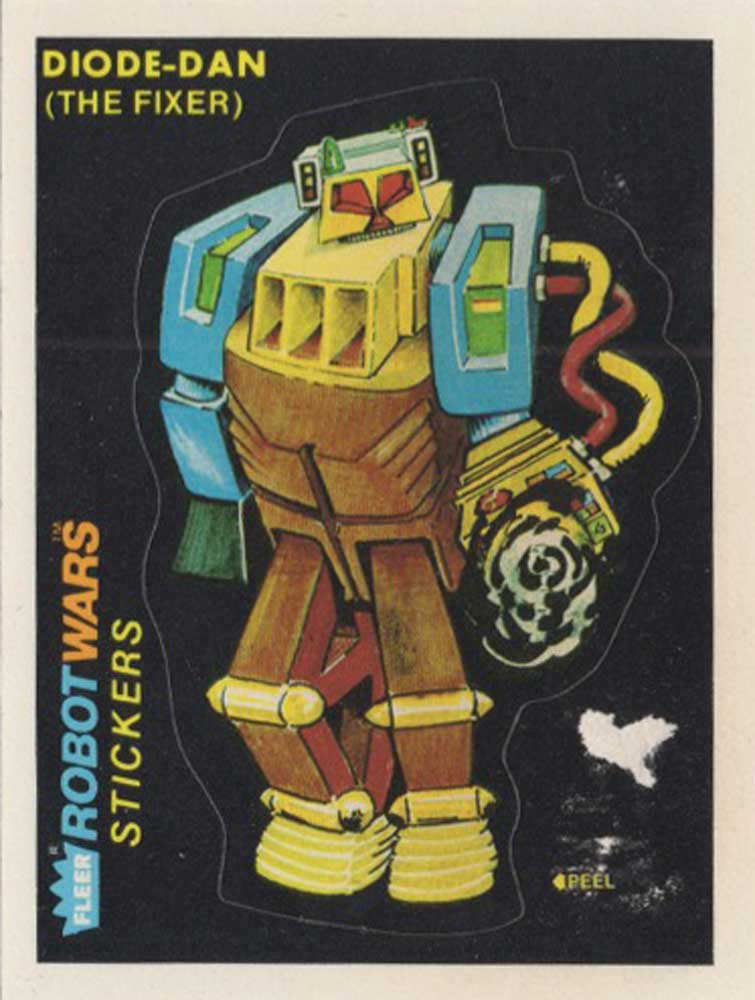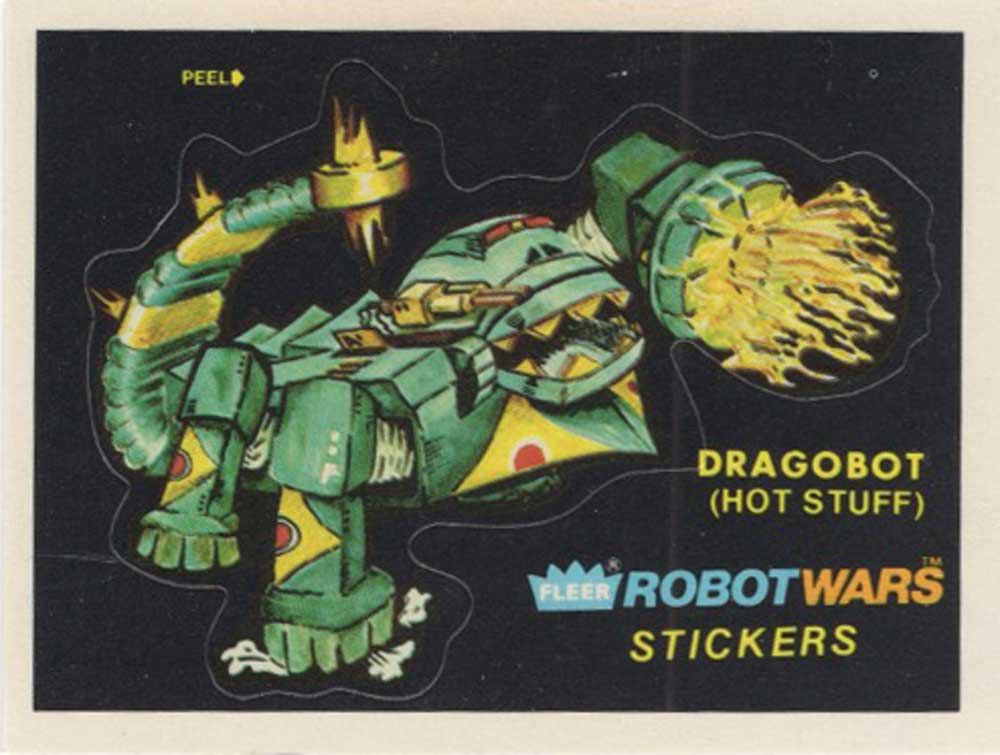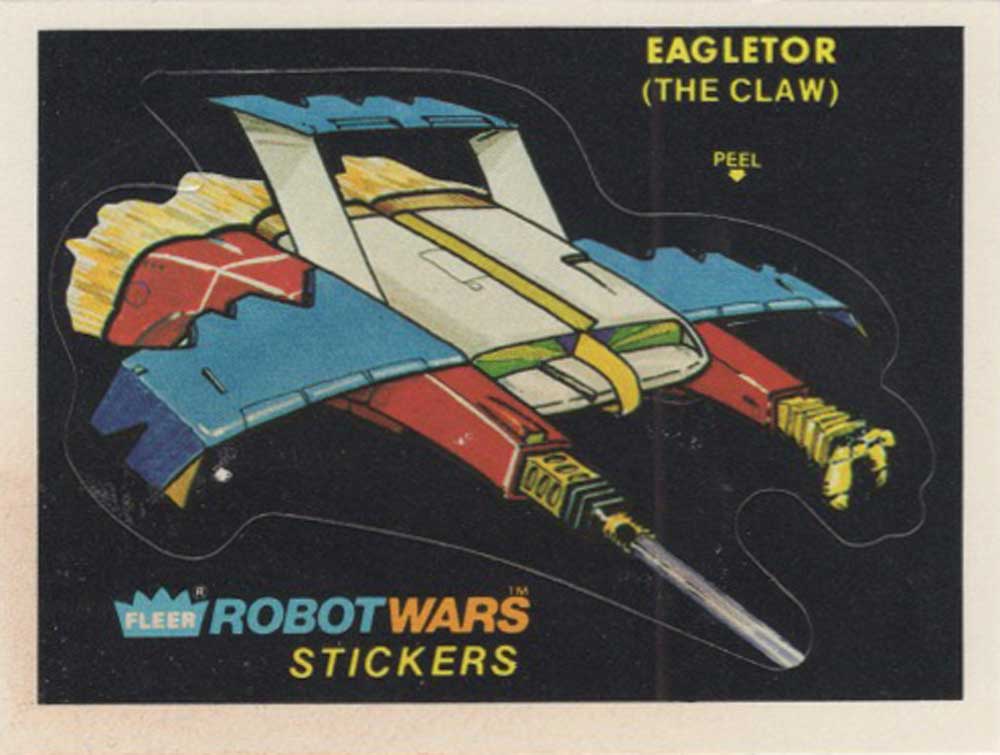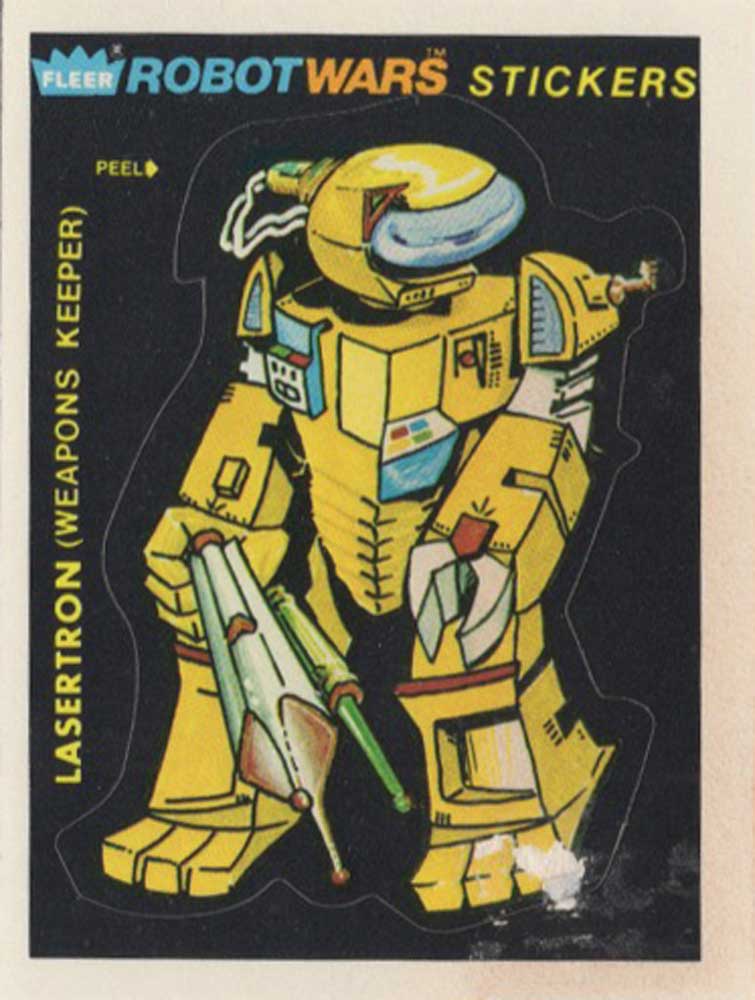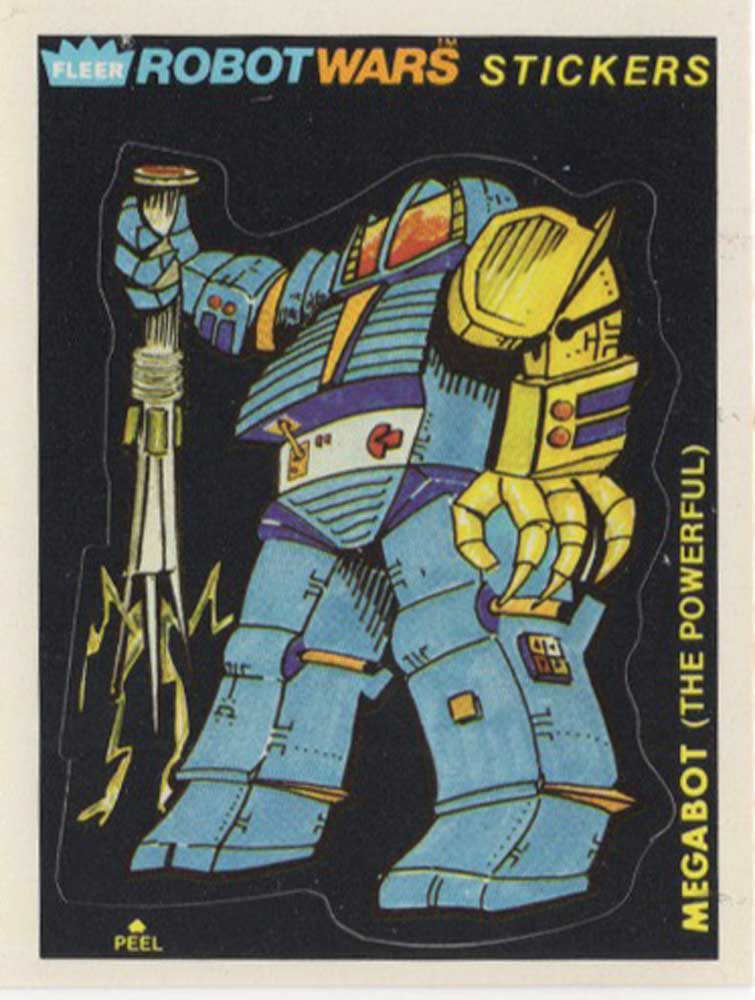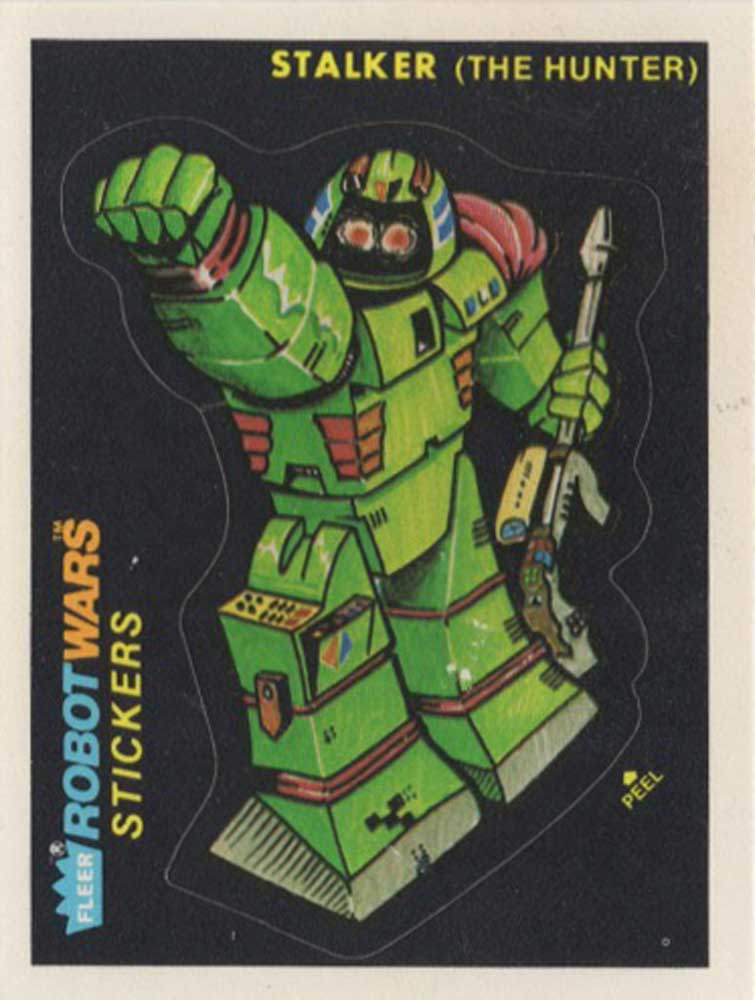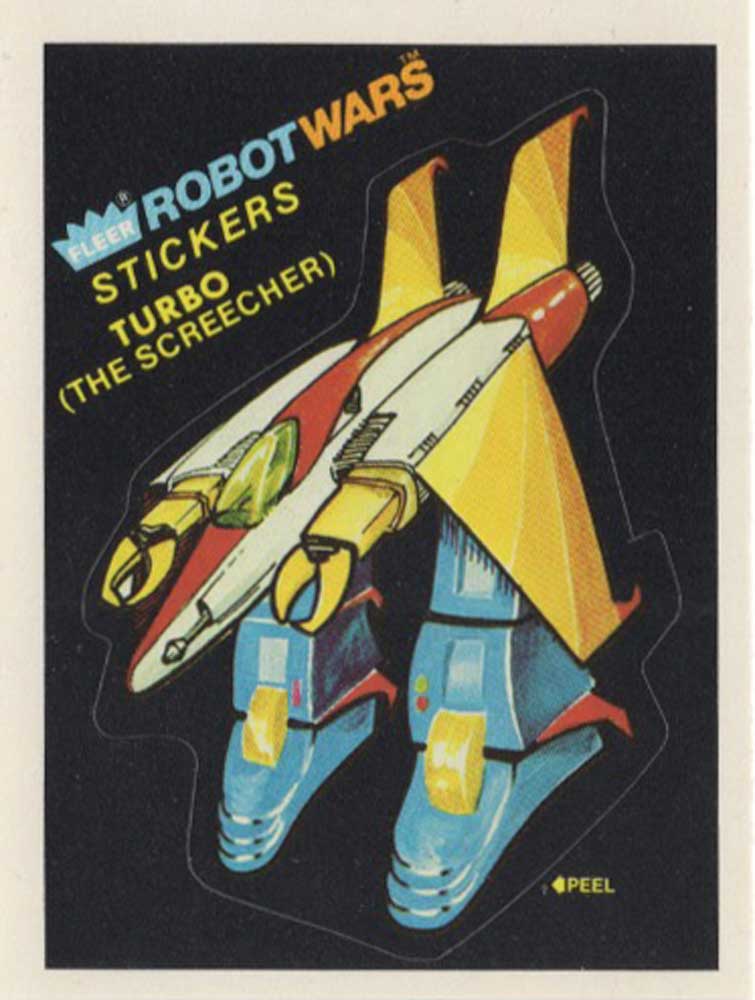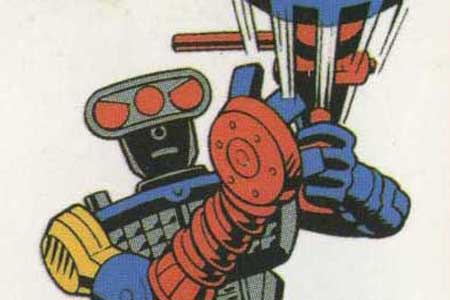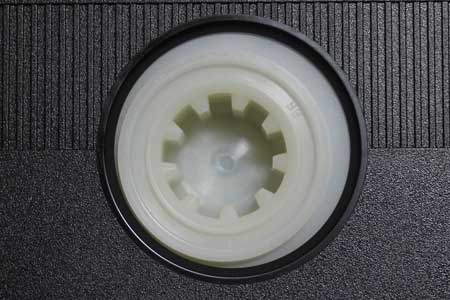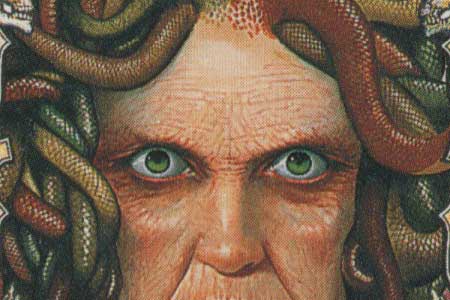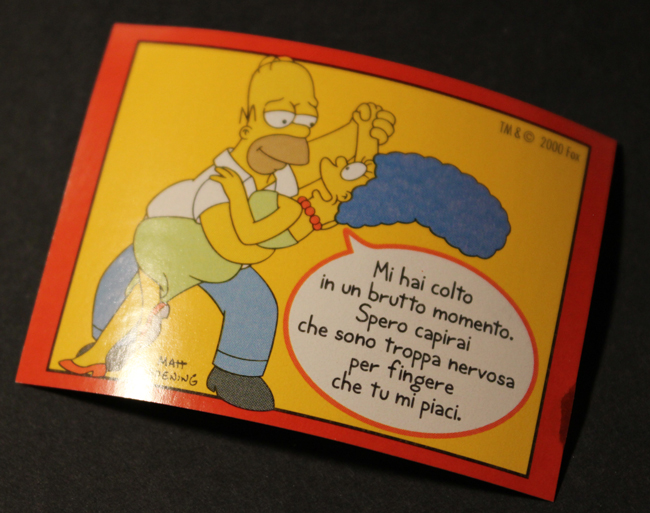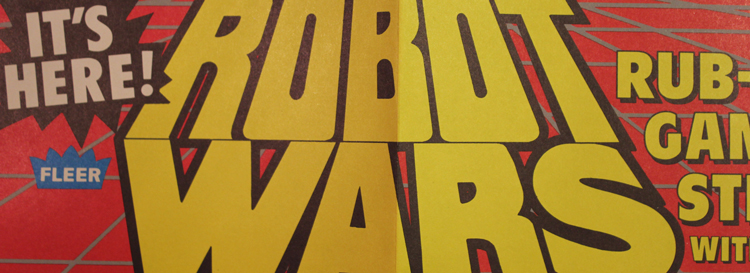
It’s 1985. Transformers have just appeared in the US, and The Transformers : The Movie isn’t due out for another year. GoBots have already been around for a couple of years, and Nintendo’s R.O.B. was fresh off the boat. We’re at the beautiful precipice of the pop culture robot revolution, with the droids of Return of the Jedi just barely out of the rear-view mirror; neon pyramids explode into the sky with laser beams that reach to the stars, and Short Circuit isn’t much more than a glint in someone’s eye. It’s an exciting time.
They’re generally forgotten among the abundance of ’80s robot junk, but Fleer’s Robot Wars cards are on the crest of that wave. It’s not a very robust set at only 37 cards, but it’s an interesting one. 11 cards are original robot designs on kiss-cut stickers, 22 cards are covered with a variety of stickers that you can stick on “GoBots, Transformers, or other robot systems”, and 4 cards are scratch-off game cards. Each pack contains 3 of these game cards, one robot character sticker, and one sheet of “robot system” stickers… and a stick of gum that, as of 2022, may or may not stick to the top card in the pack and mercilessly tear it to shreds.
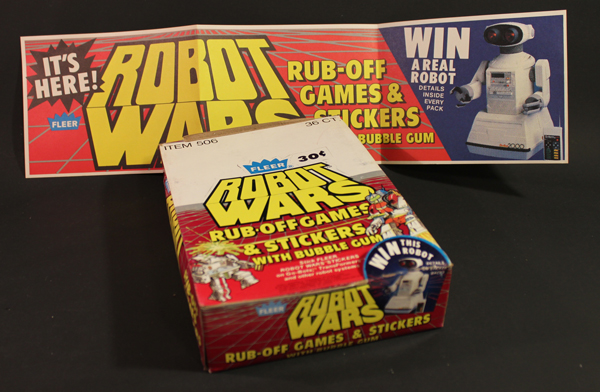
All four games are variations on the same theme : scratch off spots until you scratch off too many “bad” spots, and count up your points. All four games (Robot Wars Race, Robot Wars Rescue, Laser Defender, and an unnamed game that might just be called “Maze”) can be played solo, or can incorporate two-player rules. It’s low-impact lunchroom stuff, and that’s great; whoever wins get the loser’s Oreos. Or if your parents didn’t love you, their Hydrox. But what’s the real story here? The only time these cards get into any kind of lore of this world is Robot Wars Rescue, where you have to escape from the planet Axeion by fighting Rebel Robots. I already want to know more about this world.
And then there are the robot battle stickers. There’s pretty beautiful examples of broad, limited-color, extremely sci-fi concept designs. Any one of these would look just as good on a big plastic fighting robot as they would around the containment unit of the Ghostbusters firehouse or the Turtle Lair. More than a few of these are probably going to be used to decorate some badass VHS tapes that’ll make you wish that the horror of the 2000s and beyond just never happened. Sweet Jesus, take me back tot he days when putting stickers on robots was the project for the day, instead of the pressure to remember to rub antibiotic gel on your newest surgery scars and take your antidepressants.
The 11 original robot designs are where this set really stands out, though, and with so many animated robots running around, the Robot Wars robots wear their influences very clearly. They’re not super complex or over-designed; they actually all look like marker drawings you might find in a 4th grade vocabulary practice book, which is a real cool, energetic look. This is where the narrative starts to become a little more complex; each robot has a name, but for some reason, also has a nickname. Maybe the robot’s bolded name is a model type or something, but it’s not really made clear, but it gives the impression that these bots have human characteristics. After all, even Optimus Prime’s real name was Orion Pax (or Convoy, if you’re speaking Japanese).
Who are the Robots?
After Burner (The Flash) has a passing resemblance to RoboCop‘s ED-209, though RoboCop wouldn’t be out for another year or so, but both robots have their origins in military jets. It’s a confusing robot, with flames ejecting from its feet, a cool ’80s cockpit, and a junkpile of wings and claws that don’t seem to point anywhere in particular. It’s the kind of thing that really makes you want to launch your own set of modern Robot Wars trading cards with robots that don’t look like something an artificial intelligence would crank out from the prompt of “confusing cartoon robot”.
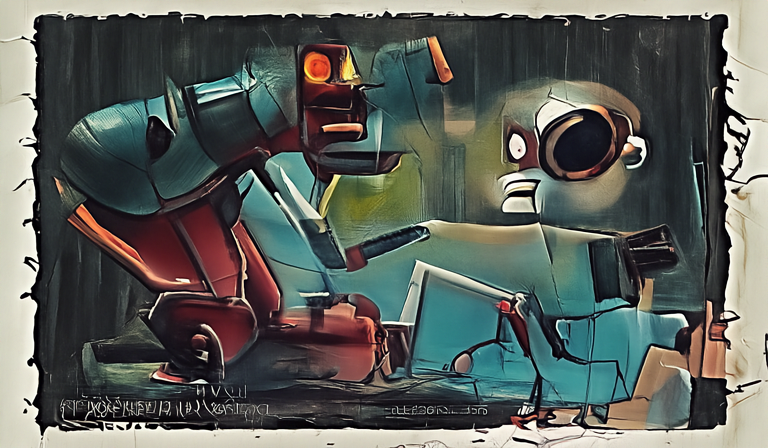
Battleblaster (The Victor) feels like it almost borrows spiritually from Micronauts‘ Force Commander, introduced in 1977. And while all of these borrow ideas from Transformers and GoBots, the all-white and funky tubes theme feels familiar. Add some back-mounted weaponry, and Battleblaster is probably one of the good guys.
Meanwhile, Big-Bite (The Crab) is maybe the first and only indication that these robots might be piloted, at least sometimes, by humanoids. Humanoids who have no idea what a crab looks like, or does, or pretty much anything you could ever observe about a crab. A quadruped robot, Big-Bite has a pair of insect-like pincers for a face, giant stomping feet, and what seems to be a cockpit with two pilots. Maybe it’s just some weird Home Alone mannequin situation, or maybe the Robot Wars are being fought between robots and people in robots. Maybe people commandeer fallen robots to fight off the invading robots in a unique twist of robot fiction where all of the ‘bots are bad guys. It just doesn’t seem like anything that calls itself The Crab could be on the side of good. Except for the incredible Sergio Mendes song.
Devildroid (The Evil) is definitely evil, because it’s in his name twice. With a name like that, you’d think that he was the leader of the bad guys, but his weapon of choice is a mace, which is pretty inefficient when you have buddies who can shoot lasers from their elbows or whatever. But maybe that’s because the clunky, weird Devilbot with the thick thighs and blobby feet prefers his murders to be cruel and slow. It blows away the theory that all of the humanoid robots are the good guys; morality in the robot world is more complicated than just counting how many legs you were built with. This guy’s bulbous exterior defies what you’d expect from a robot from this dimension… and is that his head splitting open?
Diode-Dan (The Fixer) has to be a good guy, since fixing things isn’t usually associated with evil. Bad guys just don’t fix stuff; if your weather machine breaks, you just abandon it and start working on that drill that burrows to the center of the Earth. If cartoons have demonstrated anything, evil isn’t a cumulative process, but one where you start from scratch every single time. It’s hard to piece together what Diode-Dan is based on, because he looks like a construction site came to life. There’s no indication if these bots have some kind of transforming ability, but this guys feels like he’s still finding himself.
Dragobot (Hot Stuff) is part lizard, part scorpion, and can shoot fire from its feet, and maybe tail, and maybe various tail sections. It’s here that we kind of move into vague references to any number of ’80s action figure vehicles. It just feels like something you’d awkwardly cram a couple of bad guys into, legs splayed outwards with unbending knees, and send them off to blast the good guys’ blanket fort base. It’s a goofball drawing in the best way, just a pure expression of dragon/robot-based violence.
Eagletor (The Claw) is another robot clearly based on a fighter jet of some kind, decked out in the red, white & blue of Amurrica, from those magic 250 years before the flag started getting flown alongside Nazi flags at rallies to protest the existence of science, and patriotism wasn’t inexorably tinged with extremism. The Claw has one claw, and one laser arm, and they presumably transform from one form to the other on command. It’s in full-on flight mode, but there’s some indication that its jets are also feet; if there’s anything else coherent here, it’s well-hidden. Eagletor, either the protector of humanity, or the freedom to eat horse dewormer, drink your own urine, and fit as many guns into your butt as you possibly can. The jury’s still out.
I like to think that Lasertron (Weapons Keeper) is some kind of neutral party who doesn’t ask any questions, but supplies fresh lasers to the good guys, and maybe an occasional doomsday machine to the bad guys. He just wants to get back to his home planet and finally tell that Bride of Pinbot he’s always been in love with just how he feels, and this is how he’s making the money to make that trip. And after Devildroid, he has the coolest name.
Megabot (The Powerful) has to be some kind of chunky knight, a real Volstagg kind of guy. He has a yellow replacement arm since his old one was lost or torn off (a la C-3PO), and some kind of crazy three-pronged electro-sword, which is probably a legendary weapon to his people. He’s probably the leader of the good guys, despite the “Mega” prefix being occasionally reserved for evil robots, like Megatron. Or does his asymmetry mean he’s a bad guy, like Venger or The Lich?
Stalker (The Hunter) gives off definite bad guy vibes, though “Hunters” are pretty evenly distributed between good guys and bad guys; you have Kraven the Hunter, but you also have Vampire Hunter D. Crocodile Hunter Steve Irwin and Beard Hunter. It’s a hard call, but the raised fist salute, glowing red eyes, and poor rifle discipline all say bad dude. Forget about the Masters of the Universe Man-At-Arms-like helmet and the helpful universal TV remove hip, this guy is bad.
I think we can all agree that Turbo (The Screecher) is just kinda like a Starscream riff, right? Another jet-based robot in semi-patriotic colors doesn’t feel like it’s doing too much, but I’m almost certain that this is Eagletor’s brother somehow.
A second version of Battleblaster appears on the Robot Wars box art (seen at the top of the post), and he’s fighting an otherwise unknown robot. On the back of every sticker card is an invitation to “Name That Robot”, with a picture of Tomy’s Omnibot-2000. It’s not really clear what you’re supposed to be naming—a hypothetical robot, or the already-named Omnibot, but kids could go ahead and send in their robot names and possibly win an Omnibot for themselves. And for $5.25, you could buy your own “I Survived Robot Wars” t-shirt; I can’t find any surviving examples of this today, but it’s pretty amazing.
After contacting the owners of the IP, who now seems to be Upper Deck (who acquired Fleer), nobody can seem to find anything about these cards in their official records. What I really want to know is who drew these charmingly awkward robots. They’re so perfectly 1980s kid-styled notebook doodles that I desperately want to know who put their markers to paper for these. Until then, and with the IP in limbo, I’ve put together a replica shirt.
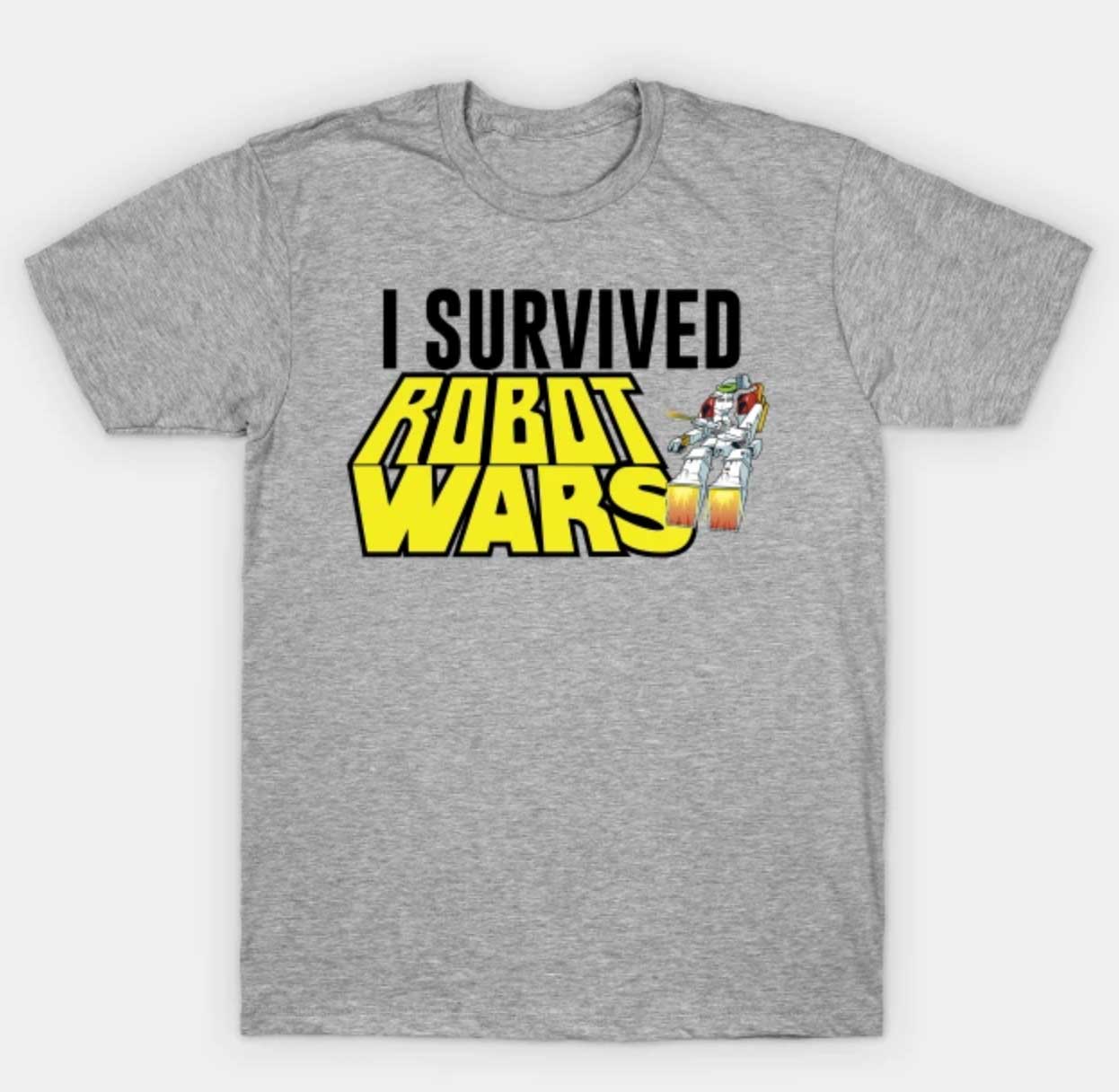
It’s always easy to dismiss things that are riding a wave as throwaway item, made only for a quick profit, and while that’s often the case at the time, these are often some of the things that had the biggest, and most unique, impact on us. Most ’80s kids have memories of Megatron, but how many had an insidious nightmare about Devilbot (The Evil)? How many other kids had nightmares about Mr. Big from Power Team, the terrible Captain N ripoff cartoon? Was it only me?
It’s the kind of thing that worms its way into your being in a special way, even if it seemed like nothing at the time. It’s why there are large communities dedicated to finding the things that live on the outskirts of your memories, like Reddit’s r/tipofmytongue.
And who was the person who designed these cards? What else did they create? It’s another thing that’s easy to dismiss, but there’s a thought process behind every one of these; even things as strange as Amicable Herculean have some unusual soul behind them, propping them up and giving them life, based on their own experiences. And becasue these thigns were produced faster, and usually more cheaply, they feel like they’re a little closer to their creators; less filtered through focus groups and committees. Maybe that’s why I’m so intensely in love with obscure indie comics, pogs, low-run VHS tapes, and other forms of almost-outsider art; they’re just so much more authentic, and Robot Wars has that feeling of authenticity, despite being published by a major trading card company.
Nothing that is created is without some kind of impact and importance, and energy. What we do with this energy is important, even almost 40 years later. These cards that sat in darkness, but find a new life now – and one day, I’ll figure out who drew these, and seek their soul. Your work has not gone unappreciated, forgotten robot artist.
 C. David is a writer and artist living in the Hudson Valley, NY. He loves pinball, Wazmo Nariz, Rem Lezar, MODOK, pogs, Ultra Monsters, 80s horror, and is secretly very enthusiastic about everything else not listed here.
C. David is a writer and artist living in the Hudson Valley, NY. He loves pinball, Wazmo Nariz, Rem Lezar, MODOK, pogs, Ultra Monsters, 80s horror, and is secretly very enthusiastic about everything else not listed here.